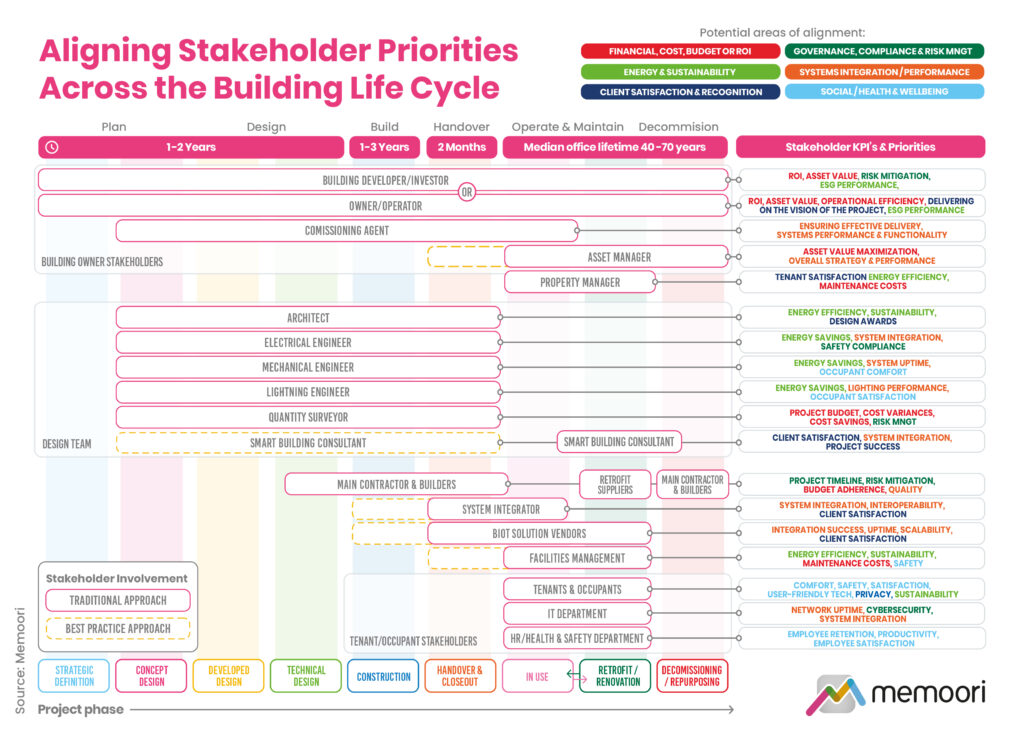A huge range of different parties have both a stake in and a role to play in the delivery of, successful smart building solutions across the life cycle of a building. Each of these stakeholders comes with its own unique set of priorities, goals, and key performance indicators (KPIs).
Achieving successful outcomes as part of smart building delivery, therefore, requires effective collaboration and alignment among stakeholders.
This article examines the importance of stakeholder alignment in smart building projects and explores strategies for fostering better collaboration to create more effective smart buildings.

As part of our latest research into the market for The Internet of Things in Smart Commercial Buildings, Memoori has prepared the figure above. This serves to identify just some of the incredibly diverse range of stakeholders that may ultimately be involved in the delivery of smart building solutions at some point along the journey from project inception to the building's ultimate decommissioning.
Each of these stakeholders may have differing levels of influence over the final outcomes of the project however, with those involved in the earlier stages having a greater influence over final deliverables and the relative success or failure of IoT-related investments.
Critical stakeholders include:
- Building owner stakeholders: represented by the building developer or owner/operator of a building, as well as representatives from their team such as the commissioning agent, asset manager and property manager.
- The Design Team, typically includes the architect, lead engineers, and the quantity surveyor.
- 3rd party contractors, including the main contractor, systems integrators, IoT, and solution vendors.
- Tenant/Occupant Stakeholders from various departments within the enterprise.
Also, clearly critical to the ultimate effective running of the building remain the facilities management team, be they 3rd party contractors or integrated into the building stakeholder team.
Furthermore, considering the involvement of additional stakeholders such as utility companies, insurers, maintenance and service providers, and government and regulatory agencies may further add to the complexity of aligning stakeholder interests.
Strategies for Fostering Improved Smart Buildings Collaboration
Developing a more rounded understanding of the priorities and goals of each stakeholder group is crucial for effective collaboration between these varied stakeholders. Many of these stakeholders ultimately share common goals, such as delivering energy efficiency, sustainability, cost savings, or occupant satisfaction.
By recognizing these shared objectives, stakeholders can work together to develop more compelling business cases for investment as well as innovative solutions that cater to the priorities of multiple groups.
For example, incorporating energy-efficient technologies in the design phase not only benefits the building owner but also contributes to meeting sustainability goals shared by architects, engineers, and tenants.
Effective communication and coordination among stakeholders are essential for ensuring that their requirements and priorities are captured, maintained, and cascaded down through the various phases of a project.
Engaging stakeholders such as smart buildings consultants earlier in the design and planning phases of a new build project can help projects deliver joined-up thinking, clearer more concise technical specifications, and ultimately more adaptable and interoperable smart buildings solutions.
Meanwhile, involving interdisciplinary teams in the planning and delivery of smart building projects can also help ensure a more holistic and integrated approach to the project.
By analyzing stakeholder priorities, several opportunities for alignment and collaboration can be identified. For instance, both the design team and tenant/occupant stakeholders prioritize occupant satisfaction and comfort. By involving tenant representatives during the design phase, architects and engineers can better understand the needs of the building users and design spaces that enhance the occupant experience.
Similarly, Memoori’s analysis reveals further potential synergies between stakeholders in areas such as system integration, risk mitigation, and energy efficiency. If they are engaged effectively during the technical design and construction phases of a project, smart buildings consultants, systems integrators and vendors of IoT platforms can more effectively collaborate with the design team to develop the kinds of shared data frameworks and interoperable data architectures that help ensure a more seamless integration of smart technologies into the building's infrastructure.
By working together, these stakeholders can address commonly faced challenges related to interoperability, scalability, and cybersecurity, resulting in more future-proofed, robust and user-friendly end results.
Aligning stakeholder interests is certainly not without its challenges, however. Securing buy-in from C-suite executives and cross-functional teams can be a significant barrier to getting projects off the ground. Agreeing on common project goals, KPIs, and systems deliverables can help build consensus across the business, improving returns and delivering more targeted outcomes. A failure to address stakeholder concerns during the project planning process can lead to breakdowns in communication and ultimately hinder project success.
Industry Initiatives and Future Outlook
Memoori has long lamented the lack of joined-up thinking and integration of smart building-specific expertise into the planning and design processes for buildings, and we are therefore encouraged to also see other organisations also exploring the challenges and modifications to traditional approaches and thinking that will be required to bring about change. In this regard, readers may also be interested in the Cisco-led Smart Building Overlay to the RIBA plan of work (currently a straw man for discussion), which is also seeking to nudge the industry towards consideration of digital capability earlier in the building design process.
Whatever approach is ultimately taken, our research and engagement with stakeholders across the supply chain leads us to believe that as the complexity and importance of IoT technology continues to rise, effective stakeholder alignment remains vital for the successful development and implementation of smart building projects.
By fostering improved collaboration, understanding shared objectives, and improving communication and coordination among stakeholders, smart buildings projects can achieve more effective, efficient, and user-friendly outcomes. By adopting a holistic approach and involving all relevant stakeholders from the earliest stages, the smart building industry can continue to evolve and deliver increasingly innovative and valuable solutions.
What strategies have you found most effective in aligning stakeholder interests and fostering collaboration in smart buildings projects?
This article was written by Owen Kell, Senior IoT Research Associate at Memoori.



